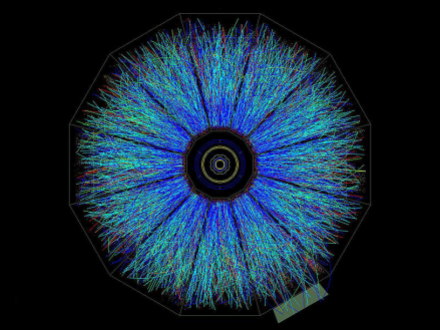Physicist: Yes, but it wouldn’t be easy.
Anti-matter is generated one particle at a time, randomly, during high-energy collisions. These collisions produce all kinds of particles, including a lot of light (which is just wasted energy). But if you want to collect anti-matter, what you’re looking for is anti-protons and anti-electrons (also called “positrons”).

High-energy collisions create sprays of random particles (both matter and anti-matter) with random speeds and directions.
Anti-matter can be gathered, but it’s very slow going (only a handful of particles can be created and gathered at a time). And, of course, you can’t just put it in a mason jar. Anti-matter annihilates when it touches any kind of matter at all, so it needs to be stored in an absolute vacuum and suspended away from the walls of the container using the only forces we have access to; electric and magnetic.
The anti-matter created and used in some particle accelerators can be contained using “magnetic bottles” which unfortunately only work with charged particles. If you’ve got just a few charged particles in a bottle then they won’t repel each other too much, but if you get too many they’ll eventually overwhelm the containing magnetic field. So, keeping a cloud of completely ionized anti-protons around is pretty out of the question. To neutralize them they can be combined with anti-electrons to create neutral anti-hydrogen. This is easy enough, however once anti-matter (or any kind of matter) is electrically neutral it tends to fall out of the field that’s holding it, and annihilates when it hits the bottom of the containing vessel.
Neutral matter is normally very difficult to keep suspended in a magnetic field. There are a relatively few elements that respond well to magnetic fields, such as iron and cobalt, but most materials barely react to magnets at all. The reaction that normal materials do have is pretty much just a reorientation of their individual electrons, which is generally a very small effect. It takes a surprisingly powerful magnetic field to get an ordinary material to budge.
Liquid hydrogen (and also liquid anti-hydrogen) is a little bit paramagnetic, so you might be able to keep it suspended in a carefully controlled magnetic field. However, there are plenty of engineering difficulties.

Water, which is diamagnetic, being suspended in a sufficiently strong magnetic field of about 10 Tesla.
You’d need an very strong magnetic field, and you’d need to keep the hydrogen close to absolute zero to keep it liquid in a vacuum.
Ideally, you’d like something like anti-iron, which is pretty easy to keep suspended and doesn’t require any special preparation (other than the vacuum), instead of anti-hydrogen. However, getting elements other than hydrogen always involves fusion, which is notoriously difficult to control; we can make fusion bombs, but not fusion power-plants. With anti-matter, not only does the reaction have to be controlled, but it has to be executed entirely without touching the anti-matter at any time. So, best to stick with just the anti-hydrogen.
Anti-matter (anti-hydrogen in particular) requires a hell of a lot of energy to maintain the magnetic fields, and a really good vacuum pump. Anti-matter is really dangerous stuff to keep around. The only other stuff that comes close to creating the kind of bang that anti-matter can create is nuclear weapons, but if you leave a nuke on a shelf for too long it becomes inert (safe), while anti-matter never loses its punch (dangerous). On the other hand, while a nuclear weapon is very difficult to set off correctly, there is no wrong way to set off anti-matter. The most powerful nuclear weapon ever set off weighed about 30 tons and released about as much energy as a 1 kg chunk of anti-matter.
Despite a “glowing” recommendation like that, in terms of efficiency you get a much better return from fissionable materials (nuclear weapons), considering that you can just dig up the material and then release its energy. All anti-matter is the result of highly inefficient direct energy-t0-matter conversion. The total energy released by an anti-matter bomb is always substantially less than the total amount of energy that went into the production.
But, long story short; anti-matter weapons are possible, but not practical.
The water droplet photo is from here.







11 Responses to Q: Would it be possible to create an antimatter weapon by “harvesting” enough antimatter, containing it in an electro-magnetic field and placing that in a projectile?